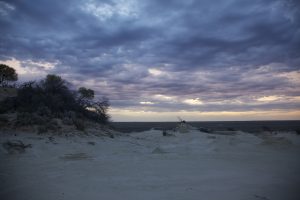Pleistocene Landscapes (May 8, 2019)
Written by Prof. Ann McGrath
Published by ARC Laureate Program for the Deep Human Past and the Indigenous Linguistics Alliance, Australian National University (ANU)
The hills around the empty lake are known as lunettes, and indeed the landscape looks other-earthly, a lunar-scape of sudden twisting wurly wurlies that Aboriginal people say are the living spirits of their ancestors. The sudden silences of the roaring wind encircle the dry salt-scapes of three once vast lakes. This landscape lives and breathes.
The first time I visited the desiccated Pleistocene Lake, Lake Mungo, I wanted to ‘see’ deep time. As a historian, I was keen to understand how we might convey the exceptionally long history of Aboriginal people on the vast Australian continent – now estimated as at least 60,000 years. Yet most of our histories begin in 1788, with the arrival of European occupants. The great depth of Aboriginal time is seen as ‘outside history’ and too far beyond the historical imagination. In the late 1960s, the ritual cremation of a young woman came to the eroding surface; today she is known as Lady Mungo. A few years later the full burial of a man was sighted; he was anointed in a rich red ochre imported from afar. Many more human and other remains surfaced, indicating a vast, enduring human settlement.
At Lake Mungo, I learnt that the colours of the stratigraphy literally tell the time – the reds, greys and ochres of the Gol Gol, Mungo and Zanci layers indicate climatic patterns stretching approximately 10,000 years in duration. The wind constantly erodes and reshapes the landscape. Its actions uncover astonishing mementos of modern humans – of homo sapiens, who, like us, lived their everyday lives in a once-present moment. I saw and touched the ancient fireplaces where people had gathered for emu egg feasts. Gleaming in the sun were fish otoliths, the inner ear common to many animals that enables ‘hearing’ – the recognition of vibrations vital to gravity, balance, movement, direction and being in place – whether in water or on land.
The Mutti Mutti, Nyaampa and Barkindji are the Indigenous custodians of the region. Anxious to ensure they are protected and at peace in their own country, they embrace the duty of caring for their ancestors. Scientific researchers removed the Mungo burial remains, and for decades held them at a laboratory at the Australian National University in Canberra. In 2017, the custodians achieved their goal of returning them home. Yet the Aboriginal women still hear Lady Mungo crying out, even gasping for air. The surface of land upon which she and her family lived has gone; now she is under the water, they say, drowning. Lady Mungo, close relative, powerful woman; it as if she only lived yesterday, and she shapes the present. ‘She surfaced for a reason,’ they say. Her timing was ordained.
I first met Andreia Pinto Correia at the Rockefeller Centre in Bellagio, Italy in 2014. We spent time together in the elegant gardens overlooking Lake Como. In a landscape steeped in European history, our studios looked out towards churches where people sang and prayed to the living spirit of another Lady, the Virgin Mary. In 2018, we travelled together to the lake where Lady Mungo lived. The ferocious winds whipped ancient grit into our ears. Wild kangaroos begged for water. Along with these gentle animals, people lived, loved and died near these beautiful waterways that sustained them.
We humans may live lives far apart in place and time but synergies bring us together to into new conversations. In profound ways, Aboriginal people taught me how the strength of connection to country cuts through time. Andreia helped me reflect on the beauty of not only ‘seeing’ time across distance, but hearing it. Andreia’s composition conveys the dynamism of Pleistocene landscapes, upon which bodies and spirits move in time along ever restless surfaces. In so doing, she has created a soundscape that transcends hemispheric divides.
Photo Credit: Ann McGrath
